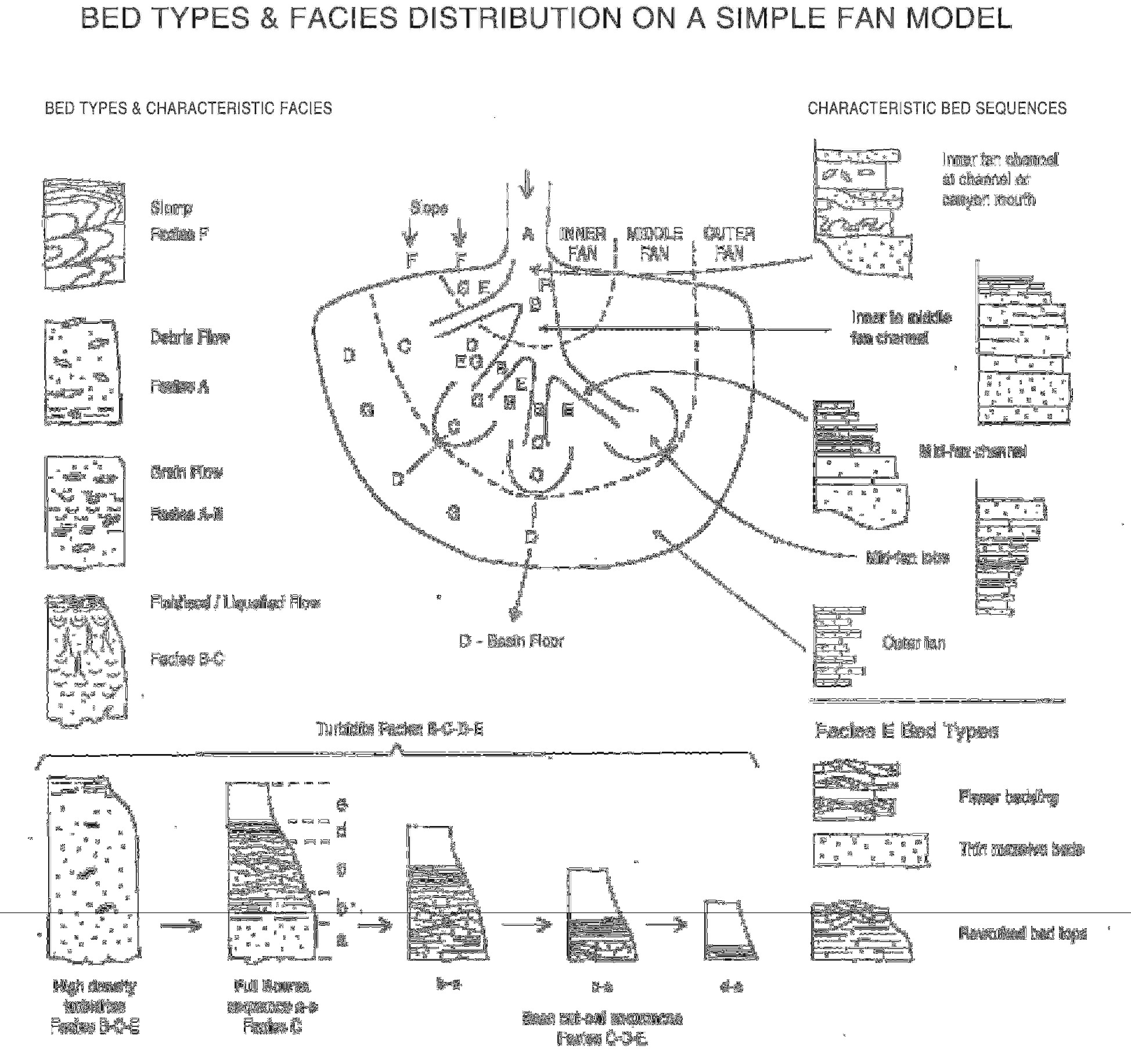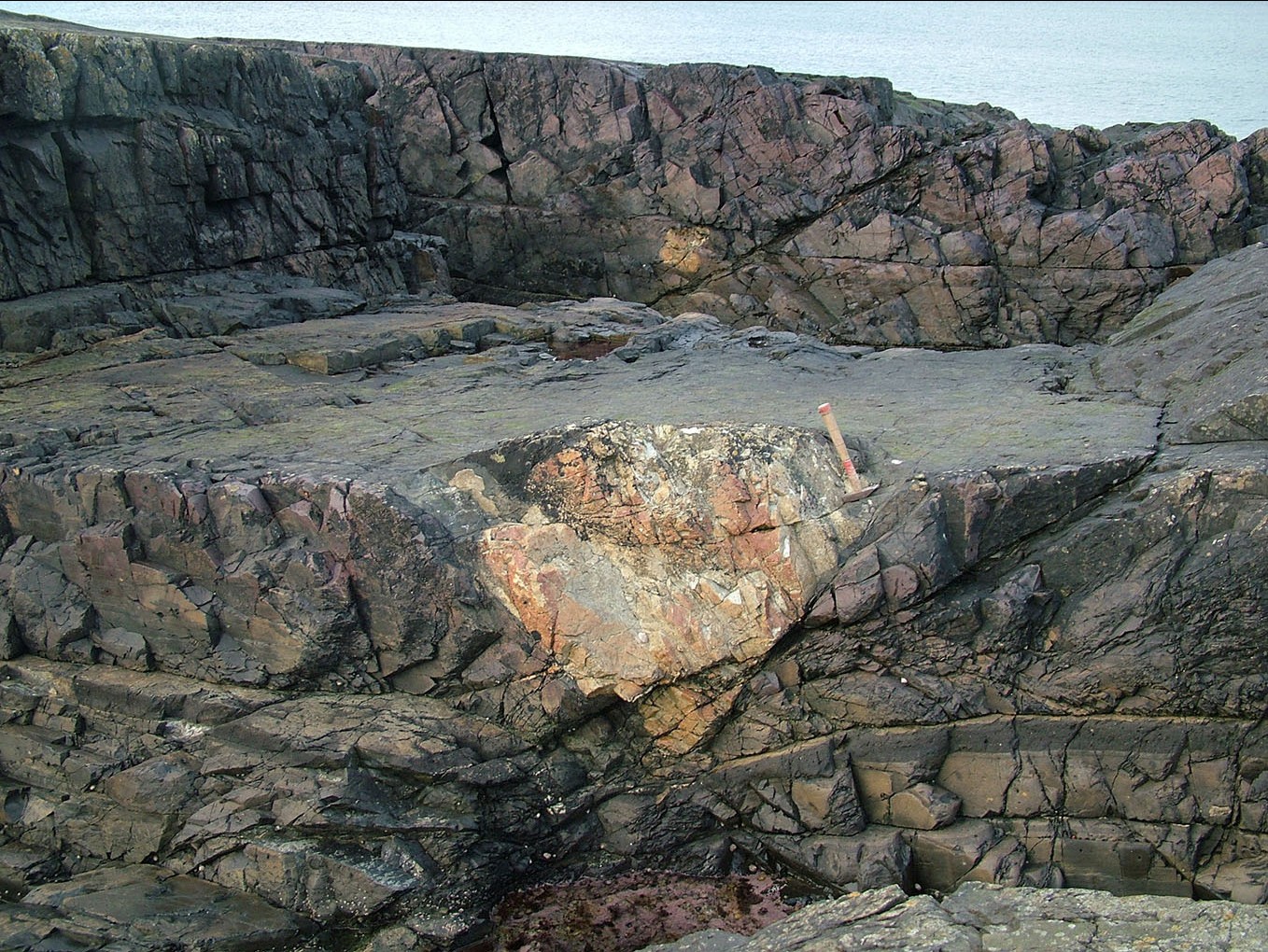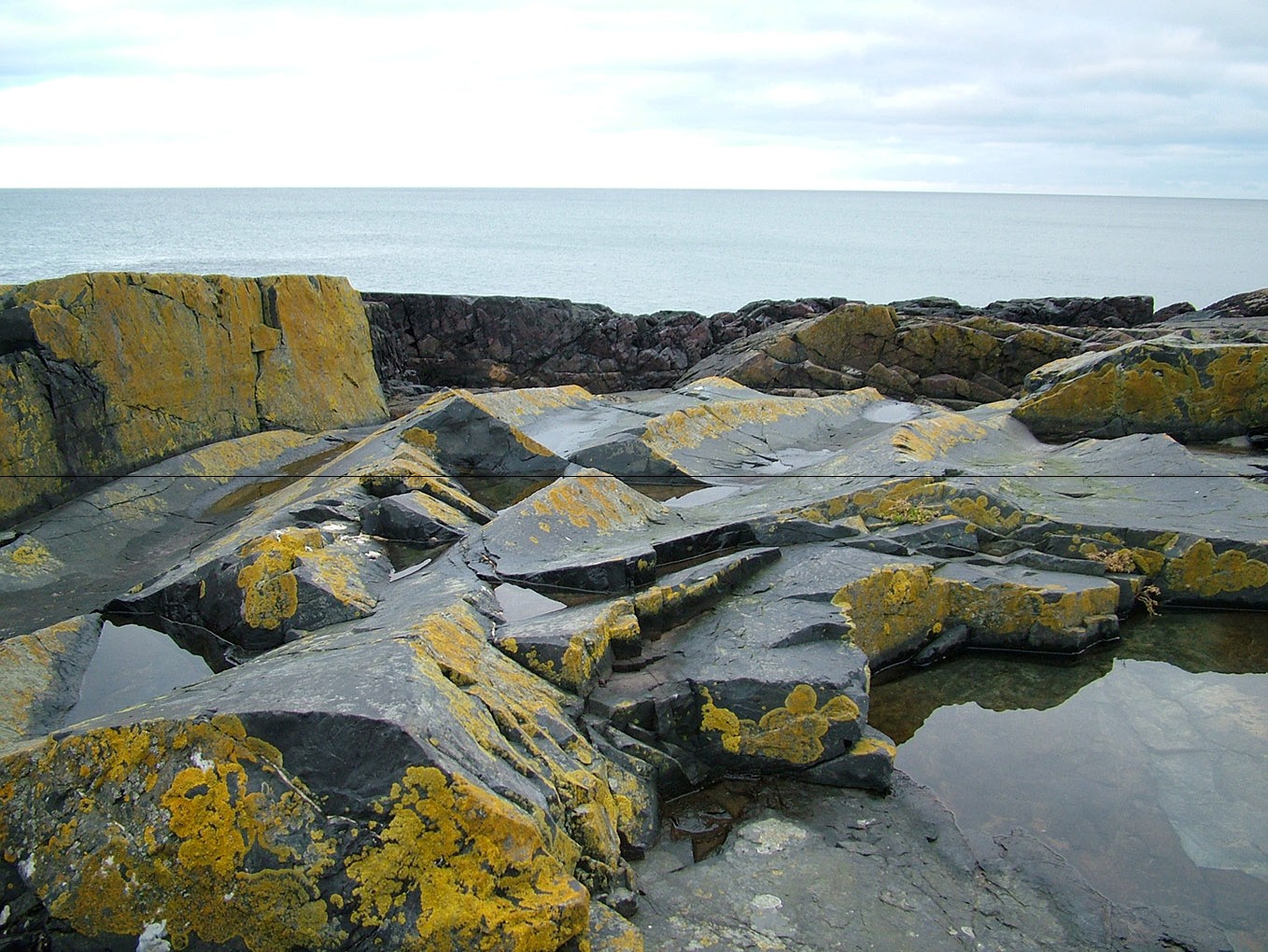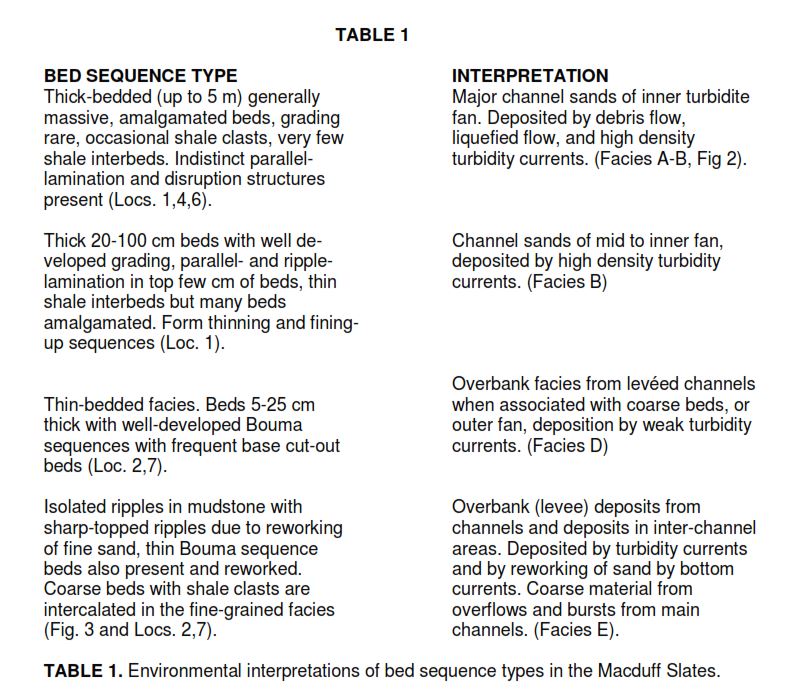Show interactive timeline
4 Macduff, Dalradian Turbidite fan and glacial deposits
N. H. Trewin
An illustrated PDF download is available from the Aberdeen Geological Society website
Purpose
To demonstrate the sedimentology of the Macduff Slate Formation (
Access
The localities described occur in cliffs and on rocky foreshore at the east end of Macduff Shore 100 m east of the last of the old cottages facing the sea, and beside the fence surrounding the grassed-over site of Macduff rubbish tip, which is now used as a recreation area. Parking is available at this point, and also in Tarlair Bay
Introduction
The Macduff Slates of the
Detailed accounts of the geological history of the area are given in Macdonald and Fettes (2007) and Trewin (ed) 2002. A poor microfossil assemblage was extracted from the Macduff Slates by Downie et al. (1971) which led them to suggest an age possibly as young as
With the exception of the Macduff Boulder Bed, the Macduff Slates are interpreted as the deposits of deep water turbidite fans of which simple models and bed types are shown in
Itinerary
Locality 1 [NJ 7120 6490]
On the shore to the west of the promontory there are good exposures with a variety of lithologies and sedimentary structures, best seen at the foot of the pebble beach where the rocks have been smoothed by wave action. Typical coarse greywackes (technically conglomerates) with abundant quartz and feldspar clasts of 5–8 mm size form beds that frequently include rip-up clasts of mudstone
The rocks forming the promontory display a wide variety of sedimentary structures and bed types. The strata strike 020° and dip 80° east. The lowest strata exposed on the west of the promontory are thick-bedded coarse greywackes. Beds are 20–100 cm thick but become amalgamated into units of up to 3 m thickness. The greywackes are massive with little evidence of internal structures.
Towards the top of this coarse-grained unit the bed thickness decreases and normal grading is well developed in the greywackes. Internal structures are rare and confined to bed tops, and shale interbeds are thin and infrequent. A typical sequence at the top of the coarse, thick-bedded unit is shown in
Locality 2 [NJ 7122 6495]
The sequence at locality 1 is immediately followed by a finer-grained thin-bedded sequence which shows the development of graded beds up to 25 cm thick, many of which display the typical Bouma sequence of internal sedimentary structures characteristic of deposition from a decelerating turbidity current (Figs 3, 7). Suitably weathered cross-sections of beds show the structures in great detail and all types of sequence can be found, but the most frequent are thin beds showing base cut-out Bouma sequences
Below the major bed with rip-up clasts is a development of thin-bedded facies with rippled fine-grained sandstone forming thin wavy beds with pale sandy ripple lenticles set in mudstone. The ripple tops are frequently sharp and appear to have been formed by reworking of fine sand by clear water currents rather than sediment-laden density currents. The ripples indicate a consistent transport direction, and they may have been formed by contour currents flowing along the basin slope. The emplacement of the overlying coarse bed has caused slight disruption of this facies giving small sandstone filled dykes. The beds exposed are typical of deep water turbidite fan deposits and the individual bed sequence types can be assigned to a number of situations on a simple fan model
After examining the turbidites and associated sediments at localities 1 and 2 it is advisable to return to the parking area and follow the landward side of the fence eastwards until a gap can be found to scramble under or over the fence. Recent erosion has made it dangerous to attempt access from locality 1 to 2 on the seaward side of the fence. The dip of the strata decreases to the east until a synclinal axis is reached which strikes N-S and plunges gently north. Descend to the flat rock platform known as The Sclates
Locality 3 Macduff Boulder Bed [NJ 7137 6492]
The Macduff Boulder Bed at this locality is at least 11 m thick but neither the top nor base are seen due to minor faulting. The majority of the deposit consists of dark coloured bedded mudstone or fine-grained sandstone with occasional pale coloured ripple lenticles giving evidence that bottom currents sorted and winnowed the sediment on the sea bed. Scattered throughout the deposit are particles of various rock types from sand to boulder size
The currents responsible for the sedimentary structures in the beds could not have transported the coarse material of the Boulder Bed. The most probable explanation for the presence of the boulders is that they were dropped from floating ice into the deep water environment (Sutton and Watson 1954). Some of the large clasts are clearly impressed into the underlying sediments, but compaction features have masked this relationship in most cases. The angular and rounded clasts were derived from glacial sediments frozen into icebergs derived from a glaciated area. The rounded pebbles were obviously water transported prior to incorporation in the floating ice and could have been derived from a river or beach environment.
A small area on the top of a reef near the sea contains the highest exposed part of the Boulder Bed. A greater concentration of pebbles (mainly limestone) within a calcareous matrix gives this patch of outcrop a different appearance but it can be traced laterally into 'normal' Boulder Bed. Hambrey and Waddams (1981) considered that this outcrop represented the top of the Upper Dalradian sequence in the area. This cannot be proven due to the local faulting present, and structural profiles and metamorphic patterns of the coast section as a whole render this highly improbable. They also likened this small outcrop to a lodgement till, deposited by grounded ice. This is also unlikely in view of the deep water nature of the rest of the sequence, and it seems more likely that this was a patch of stones dropped frozen together from floating ice, for which there are numerous
On the flat surface on the synclinal axis a series of rounded troughs separated by sharper ridges are exposed oriented N–S
A prominent inclined bedding surface close the rough path that descends to the small bay to the west of the Sclates is covered in slickensides formed due to bedding-plane slip during folding
On the wave smoothed west wall of the small bay to the east, the details of the ripple- lamination and bedding within the Boulder Bed can be examined and scattered pebbles found throughout the deposit. A fault intervenes in the gully at this point and (seen only at low tide) the rocks exposed in the bay are generally fine-grained, with ripple-lamination in thin beds. No dropped-in pebbles have been found in these rocks. This interpretation differs from that of Hambrey and Waddams (1981) who continue the dropstone bearing deposit into the bay and do not recognise a faulted margin.
A similar glacial dropstone facies, up to 22 m thick is exposed 4 km to the east of Macduff in a bay east of the Head of Garness
Locality 4 [NJ 7145 6485]
The excursion continues with further examples of turbidite fan deposits. Cross the small bay and ascend the path up the grassy slope into the western end of Berrymuir Quarry. The rocks described for this locality in the 1987 guide (Trewin 1987) are no longer exposed due to ‘landscaping’ of the quarry when the Wastewater Treatment Works was built. A section in very thick-bedded (to 5 m) coarse-grained greywackes in which individual beds are mostly amalgamated was formerly exposed. In environmental terms this thick-bedded facies probably represents the fill of large channels on the mid to inner fan area
|
Bed sequence type |
|
Thick-bedded (up to 5 m) generally massive, amalgamated beds, grading rare, occasional shale clasts, very few shale interbeds. Indistinct parallel- lamination and disruption structures present (Localites . 1, 4, 6). |
|
Thick 20–100 cm beds with well developed grading, parallel- and ripple- lamination in top few cm of beds, thin shale interbeds but many beds amalgamated. Form thinning and fining-up sequences (Loc. 1). |
|
Thin-bedded facies. Beds 5–25 cm thick with well-developed Bouma sequences with frequent base cut-out beds (Localites 2, 7). |
|
Isolated ripples in mudstone with sharp-topped ripples due to reworking of fine sand, thin Bouma sequence beds also present and reworked. Coarse beds with shale clasts are intercalated in the fine-grained facies |
|
Interpretation |
|
Major channel sands of inner turbidite fan. Deposited by debris flow, liquefied flow, and high density turbidity currents. (Facies A-B, |
|
Channel sands of mid to inner fan, deposited by high density turbidity currents. (Facies B) |
|
Overbank facies from levéed channels when associated with coarse beds, or outer fan, deposition by weak turbidity currents. (Facies D) |
|
Overbank (levee) deposits from channels and deposits in inter-channel areas. Deposited by turbidity currents and by reworking of sand by bottom currents. Coarse material from overflows and bursts from main channels. (Facies E). |
Locality 5 [NJ 7164 6485]
The quarry face near the two white concrete silos displays similar sequences of greywacke turbidites to those already described. The strata generally strike close to 020° and are cut by several steeply inclined faults or shear planes which tend to fault out the axes of the folds. Anticlinal and synclinal axes can be observed with anticlinal axes trending around 020° and plunging north at 10° Landscaping has obscured some of the structures on the quarry face but they can be examined in the adjacent sea cliffs. On the beach north of the blue building in the treatment works a sharp anticlinal axis is easily examined
Locality 6 [NJ 7182 6475]
The cliffs at the western side of Tarlair Bay are composed of typical thick bedded, coarse- grained turbidites showing similar features to those at locality 1. Thick amalgamated beds with mud clasts are well exposed, and a rare instance of cross-bedding is seen. These are likely to be major channel deposits of a turbidite fan. The bay is cut in predominantly fine- grained units which can be examined at low tide on the rocky intertidal platform.
Locality 7 [NJ 7185 6430]
An isolated 2 metre-thick bed of coarse greywacke crosses the shore and rests on mudstone beds, and thin ripple-laminated beds. For some 50 cm below the base of the coarse bed the fine-grained lithologies have been strongly folded with the axial planes of the folds parallel to bedding. This folding appears to have taken place due to shear in the soft sediment at the time of emplacement of the coarse bed. Between this bed and the promontory within the bay which contains the natural arch known as the Needle's Eye, there are good exposures of the ripple-laminated lithology previously described at locality 2, and tentatively assigned to contour currents. There are also massive mudstones in which lamination is frequently indistinct and in places is clearly folded. It is possible that these mudstones were emplaced by slumping and represent 'Facies F' of
Locality 8 [NJ 7190 6465]
After crossing a synclinal axis, the coarser grained turbidites seen at locality 6 again appear though now younging westwards. Some beds are underlain by distorted strata as described above at locality 7.
References
ANDERTON, R. 1985. Sedimentation and tectonics in the Scottish Dalradian. Scott. J. Geol. 21,407–36.
DEMPSTER, T.J. et al. 2002. Timing and deposition, orogenesis and glaciation within the Dalradian rocks of Scotland: constraints from U-Pb ages. J. Geol . Soc. Lond. 159, 83–94. DOWNIE, C. LISTER T.R., HARRIS. A.L. and FETTES, D.J.1971. A palynological investigation of the Dalradian rocks of Scotland. Rep. Inst. Geol. Sci. No. 7119.
HAMBREY, M.J. and WADDAMS, P. 1981. Glacigenic boulder-bearing deposits in the Upper Dalradian Macduff Slates, northeastern Scotland. 571–5 In Hambrey, M.J. and Harland, W.B. (eds). Earth's pre-
HUDSON, N.F.C. 1987. Macduff to Whitehills, Buchan type regional metamorphic zones. 89–98 In Trewin, N.H., Kneller, B.C. and Gillen, C. (eds). Excursion guide to the Geology of the Aberdeen Area. Scottish Academic Press, Edinburgh.
MACDONALD, R. and FETTES, D.J. 2007. The tectonomagmatic evolution of Scotland. Trans. R. Soc. Edinb; Earth Sci. 97, 213–95
STOKER, M.S., HOWE, J.A. and STOKER, S.J. 1999. Late Vendian - ?
STRACHAN, R.A., SMITH, M., HARRIS, A.L. and FETTES, D.J. The Northern Highland and rampian terranes. 81–147 In Trewin, N.H. (ed) The Geology of Scotland (4th Edn) The Geological Society, London.
SUTTON. J. and WATSON. J.V. 1954. Ice-borne boulders in the Macduff Group of the Dalradian of Banffshire. Geol. Mag. 91,391–8.
SUTTON, J. and WATSON, J.V. 1955. The deposition of the Upper Dalradian rocks of the Banffshire coast. Proc. Geol. Assoc. 66, 101–33.
TREWIN, N.H. 1973. Hugh Miller’s graptolites. Scott. J. Geol. 9, 163–4.
TREWIN, N.H. 1987. Macduff, Dalradian turbidite and glacial deposits. 79–88 In Trewin, N. H., Kneller, B. C. and Gillen, C. (eds). Excursion guide to the Geology of the Aberdeen Area. Scottish Academic Press, Edinburgh.
TREWIN, N.H. (ed) 2002. The Geology of Scotland (4th Edn) The Geological Society, London.
TREWIN, N.H. and ROLLIN, K.E. 2002. Geological history and structure of Scotland.1–25 In Trewin, N.H. (ed) The Geology of Scotland (4th Edn) The Geological Society, London.














